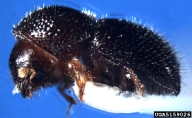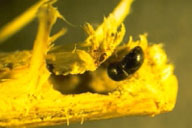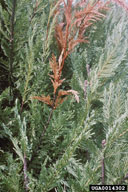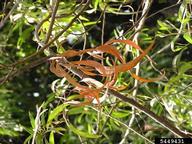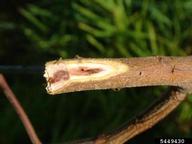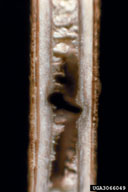Black twig borer
Xylosandrus compactus (Eichhoff) (Coleoptera: Curculionidae, Scolytinae)
Orientation to pest
The black twig borer, Xylosandrus compactus (Eichhoff), is an invasive ambrosia beetle from Asia present in Hawaii and coastal regions of the southeastern United States. Females bore into healthy twigs of over 200 hardwood species, where they lay loose clusters of eggs and inoculate their galleries with a symbiotic fungus (Fusarium solani [Mart.] Sacc.) on which their larvae later feed. Twigs may be colonized by one or several females, depending on twig size. Mature larvae pupae in the gallery and males, which are flightless, mate with females in the twig before new females emerge. Males never leave the twig. Attacked trees or other plants are usually not killed but may suffer considerable damage. In Hawaii, this species is an important pest of coffee (Coffea canephora Pierre [esp. var. robusta Ineac].
Table 1. Characteristics of four Xylosandrus species present in the southeastern United States (from University of Florida fact sheet on black twig borer seen at http://entnemdept.ufl.edu/creatures/trees/black_twig_borer.htm
| X. compactus | X. crassiusculus | X. germanus | X. zimmermanni | |
|---|---|---|---|---|
| Female size | 1.4 - 1.9 mm | 2.1 - 2.9 mm | 2.0 - 2.4 mm | 1.3 - 1.5 mm |
| Surface of declivity | Shining and smooth | Dull and granulate | Shining | Shining |
| Hair tuft on base of pronotum | Forms transverse row | -- | -- | Tuft oriented longitudinally |
| Geographic location | Throughout Florida and from North Carolina to eastern Texas | Throughout Florida and from North Carolina to eastern Texas | From Connecticut to Missouri, east Texas, and central Georgia. Might appear in north Florida. | Subtropical south Florida and Mexico to Venezuela. |
| Common host material | In small twigs on heatlhy, cut and stressed plants | In wood of large twigs, small branches and stems | In wood of large twigs, small branches and stems | Only in unhealthy, cut, or broken branches 1-3 cm in diameter |
Hosts commonly attacked
Hosts are quite varied but include maple (Acer spp.), hickory (Carya spp.), magnolia (Magnolia spp.), dogwood (Cornus spp.), oaks (Quercus spp.), willows (Salix spp.), among others
Distribution
Black twig borer has been reported from Hawaii and in North America from coastal parts of North Carolina to Texas (USA). Globally this species has a wide distribution in tropical and subtropical areas.
Images of black twig borer
| Figure 1. Adult of black twig beetle, Xylosandrus compactus; right, adult on coffee | ||
| Figure 2. Entrance and exit holes of adult black twig beetles in a branch of a koa tree (Acacia koa Gray) in Hawaii | Figure 3. Galleries of black twig beetle larvae in magnolia | Figure 4. Death of small cypress branch (top) caused by black twig beetle; injury to Acacia koa branch (bottom) |
Important biological control agents related to this pest species
Little is known of the natural enemies of black twig beetle.
Web links for information on black twig borer
- Fact Sheet from Crop Knowledge Master | EXTension ENTOmology and University of Hawaii-CTAHR IPM
- Featured Creature Fact Sheet | University of Florida and FDACS
Articles
- Ngoan N. D., R. C. Wilkinson, D. E. Short, C. S. Moses, and J. R. Mangold. 1976. Biology of an introduced ambrosia beetle, Xylosandrus compactus, in Florida. Annals of the Entomological Society of America 69: 872-876.
- Masuya, H. 2007. Note on the dieback of Cornus florida caused by Xylosandrus compactus. Bulletin of the Forestry and Forest Products Research Institute, Ibaraki 402: 59-63.
